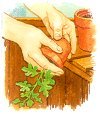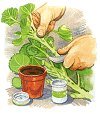Greenhouse Growing Guide

 |
JANUARY ... Sow hardy annuals for growing as pot plants. Most dwarf, compact varieties are suitable. In a warm propagator, sow slow-growing plants like begonias and Fl hybrid geraniums for summer bloom. Gloxinias, streptocarpus, and smithiantha can also be sown in the warmth of a heated propagator. Sow freesias for summer flowers. Sow salad vegetables like lettuce and carrots. Chrysanthemums and carnations can be propagated from cuttings using small shoots growing from plants saved from last year. New cuttings can be bought from specialist nurseries. Prepare or buy-in seed and potting cormposts for the busy months ahead. Pot-on plants like calceolarias, cinerarias, primulas, schizanthus, and salpiglossis, being grown for early spring display. Watch out for leaf moulds on these, and spray with systemic fungicide if necessary. Ventilate whenever weather permits. |
 |
FEBRUARY ... Pot lily bulbs and sow seeds. Keep up successive sowings of salad crops, including radishes and beetroots. Also sow vegetables -onions, turnips, parsnips, etc.- for later transferring to outdoor plots. Sow tomatoes at end of month. Some early-flowering bulbs may be sufficiently well rooted to remove from their plunge bed. Sow border plants for the garden -e.g. delphiniums, Fl hybrid chrysanthemums and sweet peas - these will flower well the same year if given an early start. Sow flowering greenhouse pot plants like thunbergias, exacum, impatiens, cupheas, and foliage subjects like grevilleas and jacarandas. Also sow solanums for Christmas berries. Bring potted strawberries in from the garden and put in good light for an early crop. |
 |
MARCH ... Sowing of most bedding plants can be started now, but leave quick-growers like African and French marigolds, zinnias and nemesias, for a few weeks. Storage organs of gloxinias, begonias, caladiums, achimenes, gloriosas, hippeastrums and other greenhouse bulbs, can be started into growth. Pelargoniums, fuchsias and other over-wintered pot plants can also be started into growth. Shoots removed during shaping or training can be used as cuttings for propagation. Greenhouse crops like cucumbers, melons, sweet peppers, aubergines, Cape gooseberries and, again, tomatoes, can be sown now. So, too, can sub-tropical bedding for summer, such as ricinus and ornamental maize. Start dahlia tubers into growth, and take cuttings of new shoots. |
 |
APRIL ... There should be a great deal in flower now from bulbs and pot plants like calceolarias and cinerarias sown last year. Keep the temperature down to prolong the display and prevent wilting - the sun will now be quite strong. Shade the glass with blinds or paint-on shading. Ventilate when weather permits, but beware of high winds. Be on the lookout for common pests like aphids and whitefly and keep insecticides at hand for immediate action. Do not use insecticidal smokes if conditions are warm and very sunny. Watering will have to be generally increased. Avoid exposing seedlings to direct sun and make sure they never dry out. Prick-out seedlings and pot-on promptly. Water-in with Cheshunt compound to prevent damping off. Grapevines growing under glass will be producing new laterals. Tie to wires. Pinch flowering shoots back to two leaves after flower truss. |
 |
MAY ... Set out tomatoes and cucumbers in growing begs or 9in pots. Avoid growing in the border soil if it hasn't been sterilised. Attach strings or wires to roof bars to train cucumbers and melons. Tomatoes can be given vertical strings for support. Other crops like sweet peppers, aubergines and Cape gooseberries, should also be potted into their final containers and may need supports later. New plants of pelargoniums, fuchsias, chrysanthemums and perpetual flowering carnations, bought-in as rooted cuttings earlier, will need potting as roots fill the pots. Sow all kinds of greenhouse primulas, as well as cinerarias and calceolarias, for display from Christmas onwards. Harden-off bedding plants by standing them outside during the day, or placing in cold frames. |
 |
JUNE ... Greenhouse conditions need careful attention during the summer months. Make sure shading is sufficient. Don't neglect watering. Regularly damp down floor and staging. This reduces water loss from plants by raising humidity and has a cooling effect as the water evaporates. Maintain good ventilation. Tomatoes and cucumbers will be cropping if sown early. Tomatoes will not ripen perfectly in temperatures over about 80 degrees F (27C). Promptly remove all side shoots. Pick off any male flowers (no tiny fruit attached) from cucumbers should they form. Sow sub-tropical and tropical ornamentals or seeds needing moderate warmth for germination. Many of these subjects can be grown-on quite cool after germination. Some large plants can be stood outdoors to give more greenhouse space in summer. Pinch out tips of fuchsia shoots to encourage more stems to carry flowers later. |
 |
JULY ... Many vigorously flowering or cropping plants will need feeding. Use balanced feeds according to label instructions. Many plants, particularly carnations, need supports. These and begonias also need dis- budding to obtain large blooms. Keep a watch out for aphids, whitefly and red spider mite - make sure you look under foliage. Tap tomato plants and spray the trusses to ensure pollination. A proprietary tomato set spray may sometimes encourage better setting. Remove faded flowers and seed heads from pot plants to prolong flower production. Pot up lachenalia and nerine bulbs for autumn to winter display. Cucumbers and melons must be kept moist, but on no account overwatered. Take cuttings of shrubs like hydrangeas and root in pots under glass. |
 |
AUGUST ... Reduce watering melon plants as the fruits begin to ripen. All kinds of pelargoniums and many other ornamentals can be propagated from cuttings now. Make sure the stock plants are strong and healthy. Begin sowing hardy and half-hardy annuals for growing-on over winter. Examples include phlox drummondii, schizanthus, salpiglossis, larkspurs, calendulas, stocks and any choice, compact garden favourites. It pays to buy the dearer varieties for pots. Pot on arums, calceolarias, cinerarias, primulas and other pot plants sown earlier. Top dress tomatoes and cucumbers to encourage new basal stem roots. Take leaf cuttings of foliage plants like begonias, and of ornamentals like saintpaulias and streptocarpus, if they can be kept in slight warmth over winter. |
 |
SEPTEMBER ... The potting of a wide range of hardy bulbs, such as daffodils and hyacinths can now commence, but leave tulips until next month. Plunge then in moist sand or peat outdoors. Have a general tidy up, cleating out all plants past their best and removing faded flowers and fallen leaves from staging and floor. Plants that have been standing out during summer may need bringing in where there's risk of early frost. Check for health and presence of pests before doing so. Many perennials and greenhouse climbers that have flowered can be pruned back. Check whether the greenhouse needs any minor repairs or renovations before winter. Cease damping down, and clean shading paint off glass. Very gradually reduce the amount of water given to tomatoes and cucumbers. |
 |
OCTOBER ... Clear out the remaining tomato plants that are over, and right at the beginning of the month being In chrysanthemums grown-on in pots outdoors over summer. Reduce watering plants with storage organs that have finished flowering, dry off and store in frost free conditions, in dry sand, over winter. Pot tulips and Easter lillies. Sow cyclamen in warmth - if necessary, in a propagator. Inspect heating equipment and service if necessary. Plastic lining, such as bubble polythene, can be put inside the greenhouse to minimise heat loss over winter. Electric warming cables can be used for economical heating of staging or frames inside the greenhouse. Shut off any automatic watering equipment and avoid excessive humidity over winter. Bring in chrysanthemum stools and dahlia tubers and store for the winter. |
 |
NOVEMBER ... From now on ventilate freely whenever outside temperatures permit to deter grey mould fungus and fumigate with fungicide smokes for the same reason. Special attention to ventilation is needed with non-flued paraffin and gas heaters. Tap off any condensation that forms on plastic lining to get maximum light and keep all glass sparkling clean over the winter months. Many pot plants, like fuchsias and pelargoniums should now be rested by keeping on the dry side. Cut out any straggly growth. Sow lettuce and other salad crops for winter. Some can be gently forced if grown in beds with soil warming cables. Make sure you have a maximum and minimum thermometer regularly reset to check on minimum temperatures. Plant grapevines in pots, or with the roots outside the greenhouse and shoots trained inside. Dig up rhubarb crowns from the garden and force into growth under the staging. |
 |
DECEMBER ... Have some form of emergency heating ready, such as a paraffin heater, in case of freak cold spells or main heating breakdowns. There should be plenty of colour from previous sowing of cinerarias, calceolarias, solanums and primulas for Christmas cheer. Cyclamen sown about 14 months ago should be blooming, but must be kept at a steady 50 degrees F. For all plants making growth, watering should be cautious and only nicely moist conditions maintained. During longer periods of cold, water very sparingly - if at all. Some bulbs being forced for Christmas can be given extra warmth, but this may be more convenient in a warm room in the home. Pot specially retarded lily of the valley crowns for flowering pot plants. Sow more winter salad crops. Note that not all lettuce varieties are suited to greenhouse culture. |
